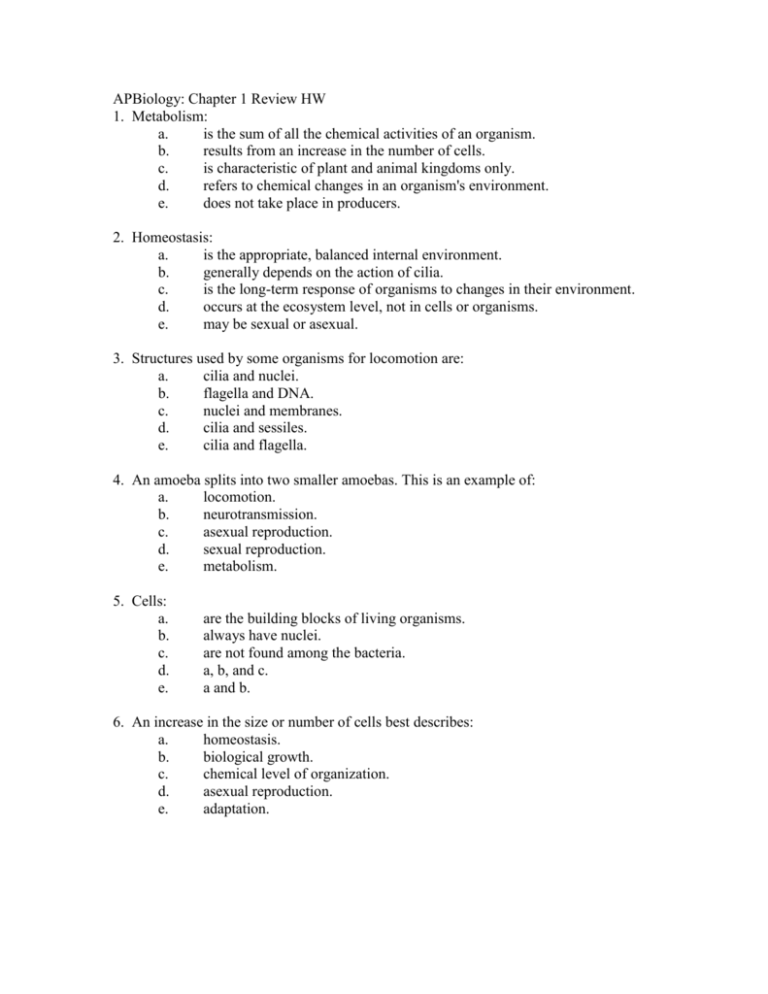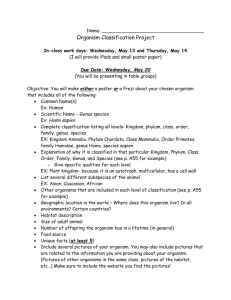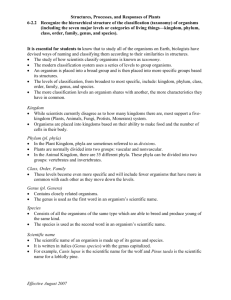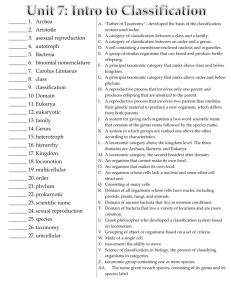APBiology: Chapter 1 Review HW - yhs
advertisement

APBiology: Chapter 1 Review HW 1. Metabolism: a. is the sum of all the chemical activities of an organism. b. results from an increase in the number of cells. c. is characteristic of plant and animal kingdoms only. d. refers to chemical changes in an organism's environment. e. does not take place in producers. 2. Homeostasis: a. is the appropriate, balanced internal environment. b. generally depends on the action of cilia. c. is the long-term response of organisms to changes in their environment. d. occurs at the ecosystem level, not in cells or organisms. e. may be sexual or asexual. 3. Structures used by some organisms for locomotion are: a. cilia and nuclei. b. flagella and DNA. c. nuclei and membranes. d. cilia and sessiles. e. cilia and flagella. 4. An amoeba splits into two smaller amoebas. This is an example of: a. locomotion. b. neurotransmission. c. asexual reproduction. d. sexual reproduction. e. metabolism. 5. Cells: a. b. c. d. e. are the building blocks of living organisms. always have nuclei. are not found among the bacteria. a, b, and c. a and b. 6. An increase in the size or number of cells best describes: a. homeostasis. b. biological growth. c. chemical level of organization. d. asexual reproduction. e. adaptation. 7. DNA: a. b. c. d. e. makes up the genes. functions mainly to transmit information from one species to another. cannot be changed. is a neurotransmitter. is produced during cellular respiration. 8. Cellular respiration: a. is a process whereby sunlight is used to synthesize cell components with the release of energy. b. occurs in heterotrophs only. c. is carried on by both autotrophs and heterotrophs. d. causes chemical changes in DNA. e. occurs in response to environmental changes. 9. Which of the following is a correct sequence of levels of biological organization? a. cell, organ, tissue, organ system b. chemical, cell, organ, tissue c. chemical, cell, tissue, organ d. tissue, organ, cell, organ system e. chemical, cell, ecosystem, population 10. Which of the following is a correct sequence of levels of biological organization? a. organism, population, ecosystem, community b. organism, population, community, ecosystem c. population, biosphere, ecosystem, community d. species, population, ecosystem, community e. ecosystem, population, community, biosphere 11. Protozoa are assigned to kingdom: a. Protista. b. Fungi. c. Bacteria. d. Animalia. e. Plantae. 12. Yeasts and molds are assigned to kingdom: a. Protista. b. Fungi. c. Bacteria. d. Archaea. e. Plantae. 13. In the binomial system of nomenclature, the first part of an organism's name designates the: a. specific epithet. b. genus. c. class. d. kingdom. e. phylum. 14. Which of the following is a correct sequence of levels of classification? a. genus, species, family, order, class, phylum, kingdom b. genus, species, order, phylum, class, kingdom c. genus, species, order, family, class, phylum, kingdom d. species, genus, family, order, class, phylum, kingdom e. species, genus, order, family, class, kingdom, phylum 15. Darwin suggested that evolution takes place by: a. mutation. b. changes in the individuals of a species. c. natural selection. d. interaction of hormones. e. homeostatic responses to each change in the environment. 16. A testable statement is a(an): a. theory. b. hypothesis. c. principle. d. inductive leap. e. critical question. 17. Ideally, an experimental group differs from a control group: a. only with respect to the hypothesis being tested. b. only with respect to the variable being studied. c. in that it is less subject to bias. d. in that it is less vulnerable to sampling error. e. in that its subjects are more reliable. 18. A systems biologist would most likely work on: a. better understanding the components of cells. b. developing a better system of classification of organisms. c. devising a new series of steps for the scientific method. d. researching a series of reactions that communicate information in the cell. e. identifying the connections and interactions of neurons in order to learn about brain function. 19. Review the image and answer the following questions. What term or phrase best fits the empty line? A. B. C. D. null hypothesis hypothesis 6 theory educated guess 20. Why is it necessary to conduct several experiments to confirm or refute hypothesis 5? A. All scientists make errors, so many experiments are needed. B. If many experiments confirm the hypothesis, then the hypothesis describes a true tenet of nature and can be used as a theory. C. Each prediction from hypothesis 5 must be tested once. D. The experiments are not separate experiments, but merely represent replication within one experiment. http://www.mhhe.com/biosci/genbio/virtual_labs/BL_01/BL _01.html 21. Go to the above site and conduct the virtual lab, filling out the table and journal pages and print to submit with this HW. 22. You are part of a group that is testing a new drug to treat migraines—25% of the control group given a placebo, (a placebo is an inert substance that looks like the medication taken by the experimental group) and 46% of the experimental group given the drug reported an improvement in their symptoms. Would you conclude that this is an effective drug? What other variables might be present in the study participants that might have influenced which patients benefited from the new drug?









